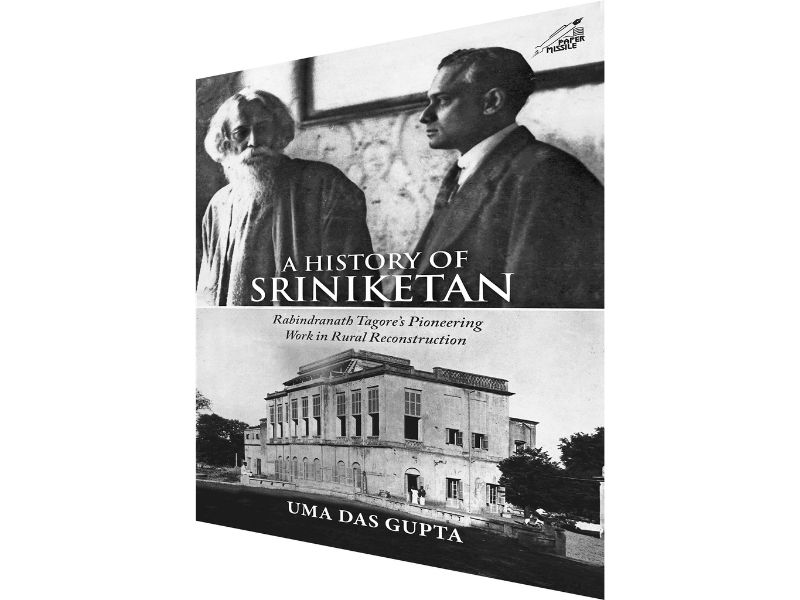Tagore’s first experience of village life and close observation of the glaring poverty of the peasantry planted the seed of the Institute of Rural Reconstruction, Nabanipa Bhattarcharjee (The Book Review)

A HISTORY OF SRINIKETAN: RABINDRANATH TAGORE’S PIONEERING WORK IN RURAL RECONSTRUCTION
Uma Das Gupta
NIYOGI BOOKS
Rs.450 Pages 234
BORN INTO a wealthy family in Calcutta in 1861, there was very little scope, so to speak, in Rabindranath Tagore’s childhood years to experience country life first hand. It was only in the 1890s, after Tagore was well past youth, that he was tasked with the supervision and management of the family’s (zamindari) estates in the rural areas of eastern Bengal.
Based in Selidaha/ Shilaidaha, headquarters of the Birahimpur estate (in the then Nadia district) located on the banks of the mighty River Padma, Tagore’s long stint in the Bengal countryside gave birth to some of his finest literary creations.
But what many of us may not be aware of is that the lengthy sojourn was the city-bred Tagore’s first direct experience of village life wherein he closely observed the glaring poverty and misery of the peasantry, and which planted the seed of the Institute of Rural Reconstruction (IRR) he would eventually establish in Sriniketan, in the Birbhum district of western Bengal in 1922.
Tagore’s unease with the dismal state of India’s villages turned him, as Uma Das Gupta writes in the blurb of this enlightening book under review, “into a man of action”. Economic development of villages was at the core of Tagore’s Sriniketan-IRR experiment but there was (also) the ‘other’ no less important goal of infusing joy into the lives of village people. He knew intuitively that poverty was not the only problem; unhappiness was also a problem.
Expectedly, the Sriniketan-IRR model combined and connected rural and urban ideas and grassroots reform, humanism and economics, science and arts/crafts, tradition and modernity, agriculture and industrial technology, local and global/universal.
This slim volume by Das Gupta on Sriniketan-IRR’s history attempts to document the work of rural reconstruction (begun by Tagore) and examine its pioneering features of integrated thought and action. “The idea… was premised on a unique proposition of ‘bringing life in its completeness’ to village India through the SantiniketanSriniketan alternative education,” writes Das Gupta.
The book is divided into 11 short chapters plus four appendices and a visuals section. Indeed the photos, curated from the collection of Rabindra-Bhavana Archive, is the real treat for Tagore lovers. Following a succinct introduction, the author narrates the causes which motivated Tagore to think about and act on the dire need of rural reconstruction in colonial India.
On this issue of the village as a site of reform, Mahatma Gandhi too was not far behind the poet, though the two differed on ways and means to address rural reform from a modern perspective. However, one of the more serious differences which Tagore had with nationalists of the Indian National Congress was about the path to be adopted to arrest rural decline in India. While the Congress “decided to pass on the work of village reform to the colonial government,” Tagore insisted that “it was the absolute duty of educated Indians to provide nation-building (rural reform) services to the people”.
In subsequent chapters the author briefly narrates the history of the Sriniketan-IRR initiative, including challenges such as landlordism, “villagers’ mentality”, problems encountered by Tagore in establishing the project while outlining its aims and objectives, organisational structure and its role in the health sector (anti-malaria research and cooperative health societies), the “endemic problem” of winning villagers’ trust, limited funds and so on.
Therefore to give shape to his ideas of rural reform, as early as 1906, Tagore sponsored the study of agriculture science of three young men including his son Rathindranath, at the University of Illinois, Urbana-Champaign, USA. By 1922, the students completed their higher studies and were back in India to begin work in Sriniketan-IRR which was inaugurated on February 6 the same year with Leonard K. Elmhirst, an English agri-economist trained in Cornell University (USA), appointed its first director.
The agenda of Sriniketan-IRR reflected Tagore’s proposal to synthesise the ideal (knowledge) with the everyday life of villagers. Accordingly, the students were based in villages and worked on “agricultural projects, animal husbandry, health, education, cottage industries, and village organisation”. The prime objective of the SriniketanIRR was to ensure that the peasant’s mind was “awakened” to realise his atmashakti and become self-reliant and attain happiness.
Tagore believed that India’s villages could be resuscitated only if cautious scientific experimentation was embraced by villagers themselves. In turn this would contribute, albeit in the long run, to build a constructive swadeshi programme of complete mental and social progress for all Indians.
Finally, the remarkable feature of Tagore’s rural reconstruction approach as also Gandhi’s, is that both in their distinctive ways, placed village communities at the centre of the economic development discourse of post-colonial India. In the circumstances one hopes Das Gupta redirects our attention towards socio-economic reform in rural India, which is the national priority obscured by peripheral issues.





















